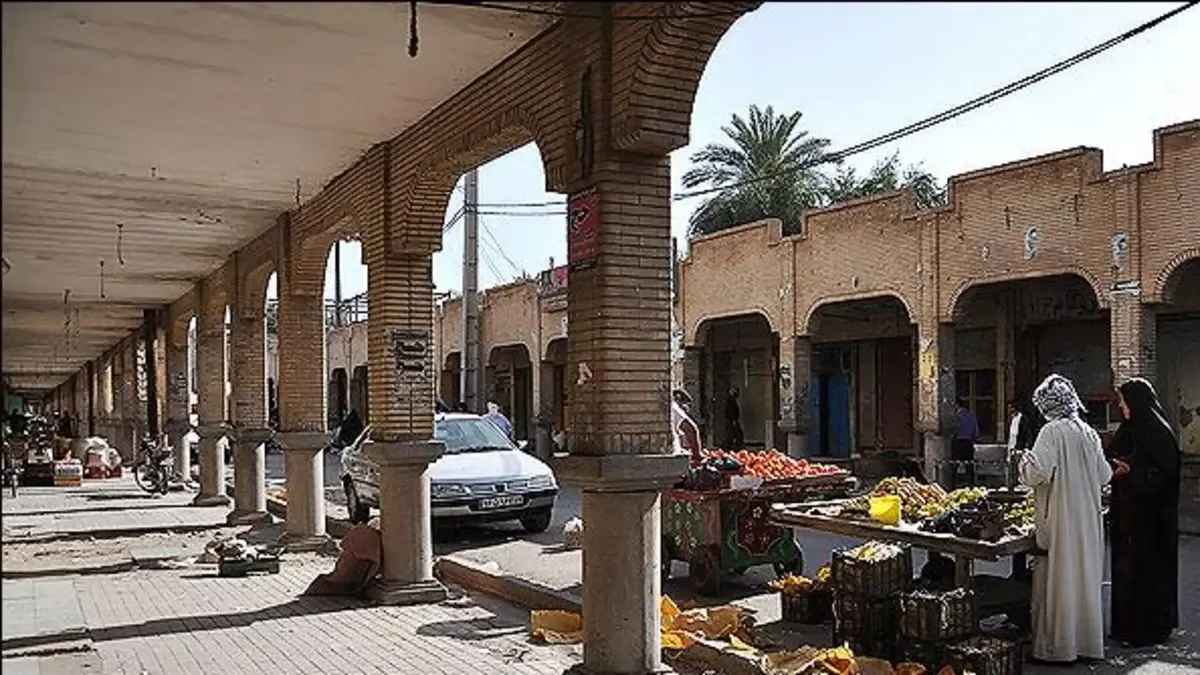The best places to see in Shiraz (photo + address + information)
Shiraz, the city of poetry and literature, is the capital of Fars Province and the cultural capital of Iran. With its countless historical, cultural, and natural attractions, this city is one of the main tourist hubs in Iran, hosting many domestic and foreign tourists annually. To ensure you don’t miss any attractions during your trip to this city, be sure to familiarize yourself with the sights of Shiraz and make a list before your journey. In this article from Gulf City Pedia, we intend to introduce you to the most important and top attractions of Shiraz.
Historical Places in Shiraz | Where to Go in Shiraz?
The historical and cultural buildings of Shiraz stand out the most when traveling to this city and showcase its significant role throughout different historical periods. The most important historical sites that you must visit when traveling to the city of poetry and orange blossoms are:
Nasir al-Mulk Mosque
Nasir al-Mulk Mosque, one of the oldest mosques in Shiraz, is located in the Goad-e-Araban neighborhood, on Lotf Ali Khan Zand Street, near Shah Cheragh. The windows of the mosque are made of colored glass, which is why it is also known as the “Pink Mosque of Iran.” It is the most valuable mosque in the country in terms of tile work, with the entire ceiling, inside, and outside covered in colorful tiles inscribed with Quranic verses. The mosque was built during the Qajar era, from 1876 to 1888, by the order of Mirza Hassan Ali, known as Nasir al-Mulk, son of Mirza Ali Akbar, the then governor of Fars, with its architecture done by Mohammad Hassan Mimar. In 1979, the Nasir al-Mulk Mosque was listed as a national heritage site by the National Heritage and Archaeology Association of Iran.
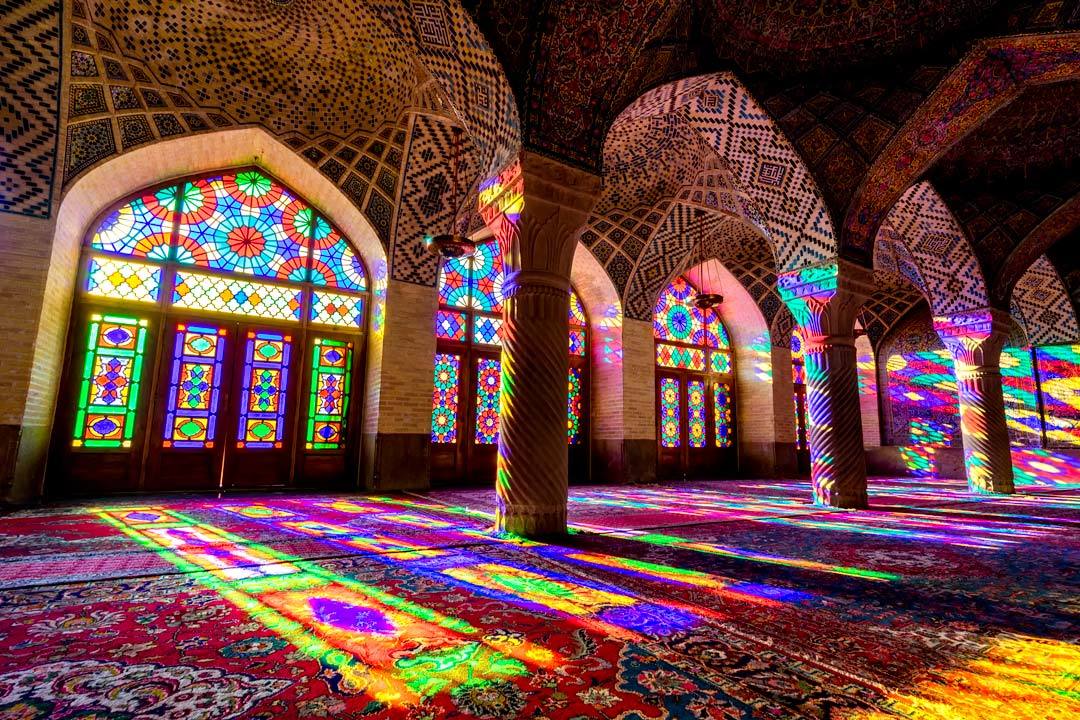
The main entrance of the mosque features a large arch decorated with seven-colored tiles and designs of roses and lilies. Above it, there is a small stone inscription with a poem by Shorida Shirazi. After the main entrance, you enter a hallway adorned with tile work similar to the entrance, below which a famous poem by Saadi and the name of the mosque’s architect are inscribed. Passing through this vestibule, you arrive at the mosque’s large courtyard, located to the north.
The courtyard of Nasir al-Mulk Mosque is square-shaped, surrounded by seven-colored tiles, with a pool in the middle in front of the mosque’s iwan (porch). The mosque has two iwans, one in the north and one in the south, which are not identical, with the northern iwan being more beautiful. The northern iwan has three half-arches on three sides, with the fourth side open to the courtyard. The central arch, which is tall, is known as the Pearl Arch and has Quranic verses and hadiths written on its walls. The northern iwan also has four alcoves with colorful tiled ceilings. The southern iwan, created to balance the northern one, has two minarets and a rectangular stone pool with a fountain in its courtyard.
Nasir al-Mulk Mosque has two shabestans (prayer halls); one in the west and one in the east. The eastern winter shabestan has a tiled ceiling and seven columns that are plain and unadorned. Behind this shabestan, there is a door leading to a water well called the Cow Well, which was historically used to house water-drawing animals. The western shabestan of Nasir al-Mulk Mosque is one of the most beautiful shabestans in Iran, decorated with tiles, bricks, and paintings of roses, making it one of Shiraz’s attractions. This shabestan, which is used in the summer, has two rows of six spiral stone columns and seven wooden doors with colored glass. During the day, the sunlight passing through these doors creates a unique and stunning atmosphere inside the shabestan.
Visiting hours: 07:00 to 17:00
Address: Shiraz, Lotf Ali Khan Zand Street, Goad-e-Araban neighborhood, end of Nasir al-Mulk Alley
Zandieh Complex in Shiraz
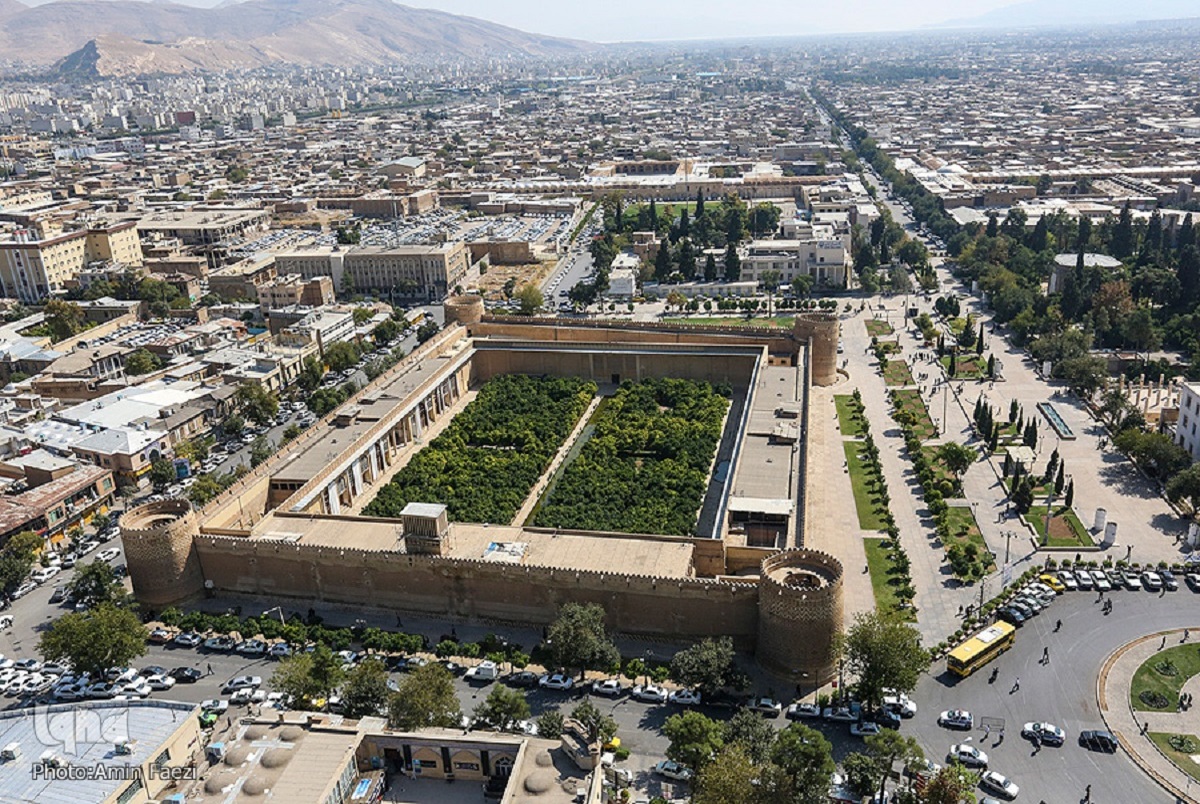
The Zandieh Complex in Shiraz is a collection of valuable buildings and monuments that reflect the cultural identity of Shiraz. The main structures in this complex include Karim Khan Citadel, Vakil Bazaar, Kolah Farangi Mansion (or Pars Museum), Vakil Bathhouse, Vakil Mosque, and Vakil Water Reservoir. These buildings hold significant architectural and artistic value. Below, we introduce these monuments:
Karim Khan Citadel
The magnificent Karim Khan Citadel is the most important and largest structure from the Zand era, built in 1180 AH by Karim Khan Zand, known as Vakil al-Roaya. During the Zand period, this citadel served as the residence of Karim Khan Zand and the royal family. During the Qajar era, local governors resided there, and during the Pahlavi period, it was used as a prison.
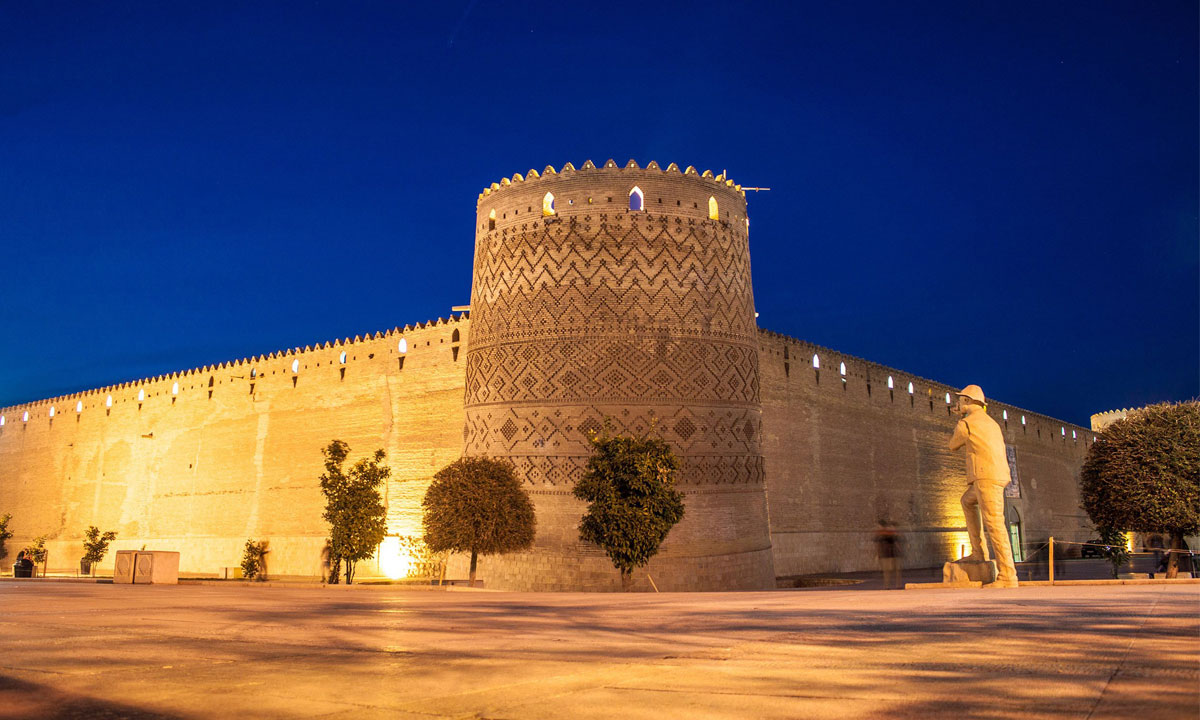
The citadel, covering an area of about 4,000 square meters, was constructed on a plot of 12,800 square meters. It features four brick towers, taller than the main wall. If you look closely at the surrounding towers, you will notice that one of them is slightly tilted due to ground settlement over the years.
Visiting hours: 08:00 to 20:00
Address: Shiraz, Karim Khan Zand Street, at the corner of Shohada Square
Vakil Mosque
Vakil Mosque, a historical mosque from the Zand period, was built by the order of Karim Khan Zand on an area of 8,660 square meters near Vakil Bazaar. The decorations of this building are very diverse and unique, including enamel work, carvings, tile work, and calligraphy that captivate every visitor. Vakil Mosque has two iwans and two shabestans (prayer halls), one in the south and one in the east. The southern shabestan, with its 48 spiral and solid columns, is considered the most attractive part of Vakil Mosque and is a hallmark of Iranian architecture.
This beautiful mosque, due to its construction and stunning architecture, is considered one of the country’s valuable buildings and was registered as a national heritage site of Iran in 1932.
Visiting hours: 08:00 to 20:00 (daily except Fridays)
Address: Shiraz, Taleghani Street, west of Vakil Bazaar
Vakil Bazaar
Another remnant of the Zand era in Shiraz is Vakil Bazaar, which is considered one of the most beautiful covered bazaars in Iran. Like all old bazaars in Iran, Vakil Bazaar has different sections and inns named according to the type of activity carried out there.
One of the most beautiful parts of Vakil Bazaar is Saray-e-Moshir, located on the southern side of the bazaar. The presence of shops with unique architecture, old wooden doors, a large central pool, and orange trees around it enhances the beauty of this inn. Other popular sections of Vakil Bazaar include the spice row, carpet sellers, and Fil Caravanserai, which are highly attractive to tourists and are among Iran’s most popular tourist spots.
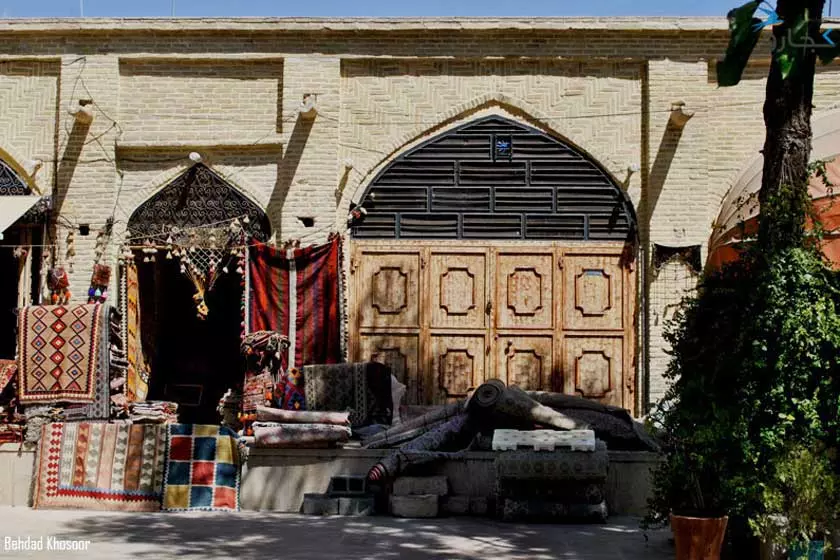
If you’re looking to buy souvenirs from Shiraz, Vakil Bazaar is one of the ideal places to shop. The bazaar has five entrances on different sides and streets: Zand, Taleghani, and Lotf Ali Khan Zand. The entrance on Zand Street and the eastern side of the Municipality Square is the busiest.
Visiting hours: 07:30 to 22:00 (daily except Fridays)
Address: Shiraz, Zand Street, eastern side of Municipality Square
Vakil Bathhouse
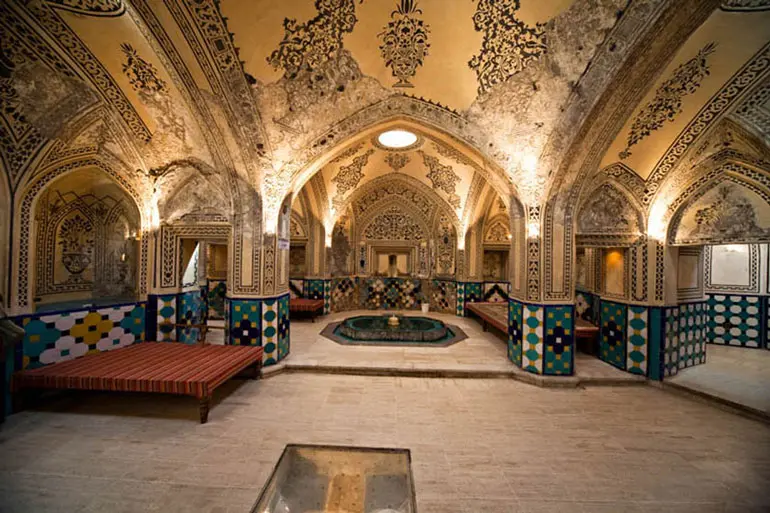
One of the most advanced examples of authentic Iranian architecture can be seen in Vakil Bathhouse in Shiraz. The bathhouse was built during the Zand era by the order of Karim Khan Zand and was one of the largest and most equipped bathhouses of its time. This historical building has undergone several changes in use over the years and is now a museum. Visitors and tourists can enjoy the attractive architecture of the bathhouse while learning more about Iran’s ancient culture and history.
Visiting hours: 09:00 to 19:45 (daily except Fridays)
Address: Shiraz, Taleghani Street, west of Vakil Mosque and Bazaar
Pars Museum in Nazar Garden
Pars Museum in Shiraz is one of the oldest buildings in Shiraz, located near Karim Khan Citadel in Nazar Garden. This octagonal building dates back to the Zand era and was used during Karim Khan Zand’s reign to host foreign guests, ambassadors, and official ceremonies.
This museum houses valuable artifacts from the 4th millennium BCE to the contemporary period, including metal objects, pottery, various seals, coins, and old documents. Among the museum’s astonishing exhibits are beautiful Qurans and manuscripts. One of the famous Qurans in this museum is the “Seventeen-Man Quran,” which was previously kept in the chamber above the Quran Gate of Shiraz. This Quran dates back to the early 9th century AH. Additionally, the tomb of Karim Khan Zand is located in this museum.
Visiting hours: 08:00 to 18:00
Address: Shiraz, Shohada Square, Zand Street
Shapouri House
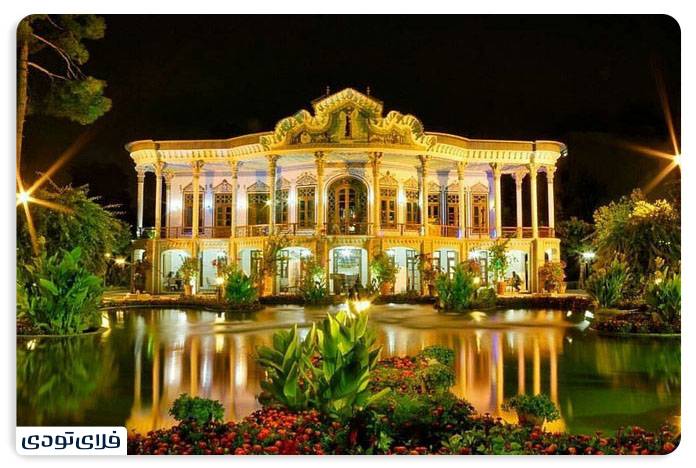
The magnificent Shapouri House is one of the most beautiful garden houses and attractions in Shiraz, a relic from the early Pahlavi era. What sets this building apart from other mansions is its unique blend of Iranian and European architectural styles. This mansion is situated in a beautiful garden with a lovely pool in front, creating a unique and picturesque view.
Shapouri House was registered as a national heritage site of Iran in 2000 and currently serves as a café and restaurant, welcoming tourists and guests.
Visiting hours: 09:00 to 24:00
Address: Shiraz, Karim Khan Zand Street, Anvari Street, Ahli Intersection, Shapouri Garden and House
Khan School | One of the First Schools in Shiraz

Khan School is one of the first schools in Shiraz, built during the reign of Shah Abbas Safavi on a 5,000-square-meter plot. This school, one of the most famous academic buildings and historical attractions in Shiraz, was once the teaching site of Mulla Sadra, one of the most renowned and greatest Iranian scholars.
Every corner of this school showcases Iranian tile work with floral and arabesque designs. In the courtyard, there is an octagonal pool, and the beautiful flower beds around it bring a fresh spirit to the place.
Interestingly, each student was assigned a specific room as a dormitory during their studies. There were originally 100 rooms, but unfortunately, only 70 remain today.
Visiting hours: 07:00 to 13:30 – 14:30 to 19:00
Address: Shiraz, Karim Khan Zand Underpass, 27, Rouhollah Bazaar, Lotf Ali Khan Zand, between 45 and 42
Khwaju Kermani Tomb
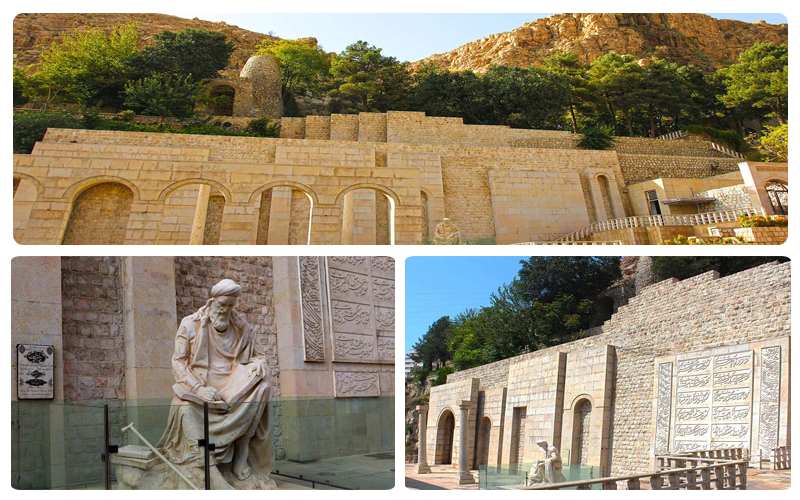
Kamal al-Din Abu al-Ata, known as Khwaju Kermani, is the greatest poet of Kerman and one of the most famous poets of the 8th century AH. His tomb is located in a picturesque area overlooking the Quran Gate. However, there is no inscription of Khwaju Kermani’s name on his gravestone.
A little higher up from the tomb, there are three caves; one of these caves was a place of worship for Khwaju Kermani, ascetics, and his followers. Another nearby cave features a relief of Rostam and the lion. This cave is the tomb of the minister of Shah Sheikh Abu Ishaq Inju, Khwaja Emad al-Din Mahmoud. The beautiful Khwaju Park is also adjacent to the tomb and offers a great view of Shiraz, making it a suitable place for leisure and sightseeing.
Visiting hours: 08:00 to 24:00
Address: Shiraz, beginning of Shiraz-Isfahan Road, Tang Allah Akbar, next to Quran Gate
House of Zinat-ol-Molouk
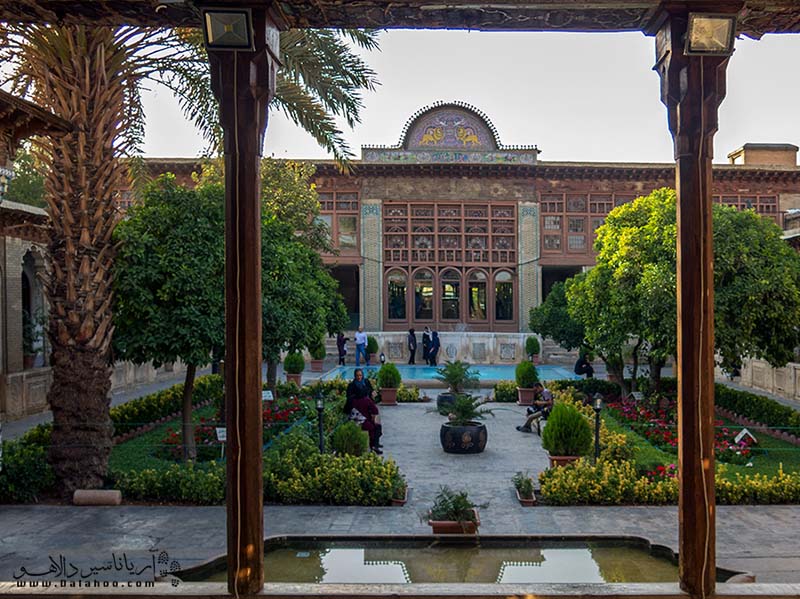
The House of Zinat-ol-Molouk is one of the historical Qajar-era houses in Shiraz and was the residence of Zinat-ol-Molouk Qavami, the daughter of Qavam al-Molk IV. The construction of this house began in 1873 by the order of Ali Mohammad Khan Qavam al-Molk II and was completed in 1923.
This house is connected to the Narenjestan Qavam Garden via an underground passage; in the past, this house served as the private quarters and inner sanctum of Narenjestan Qavam. The exquisite architecture of the building, with its wooden ceilings, intricate mirror work, and delicate plasterwork, along with painted images of flowers, birds, and animals, captivates visitors.
The spacious basement of this house has now been turned into an art gallery, displaying statues of many prominent and famous figures of Shiraz for tourists. This historical building was registered as a national heritage site of Iran in 1972.
Visiting hours: 08:00 to 19:00
Address: Shiraz, Lotf Ali Khan Zand Street, western side of Narenjestan Qavam
Narenjestan Qavam
Narenjestan Qavam, also known as the Qavam House, is one of the most beautiful mansions from the Qajar era in Shiraz. The Qavam historical complex, built by the order of Ali Mohammad Khan Qavam, consists of two parts: the exterior, including the garden and Narenjestan Qavam Museum, and the interior, which includes the House of Zinat-ol-Molouk. The Qavam complex served as a local government office for military and political activities until it was handed over to Shiraz University in 1966.
The main building of Narenjestan has two floors and a basement. The mansion is adorned with stunning arts such as mirror work, stucco, woodwork, traditional paintings on walls and doors, stone carvings, and mosaic work. The basement of the mansion serves as a museum, showcasing items like old pottery, coins, traditional tiles, and many other artifacts for visitors. As the name suggests, the garden is filled with numerous orange trees, adding a pleasant atmosphere to the estate.
Visiting hours: 08:00 to 21:00
Address: Shiraz, Lotf Ali Khan Zand Street
Saadi’s Tomb | Beloved Poet of the 13th Century
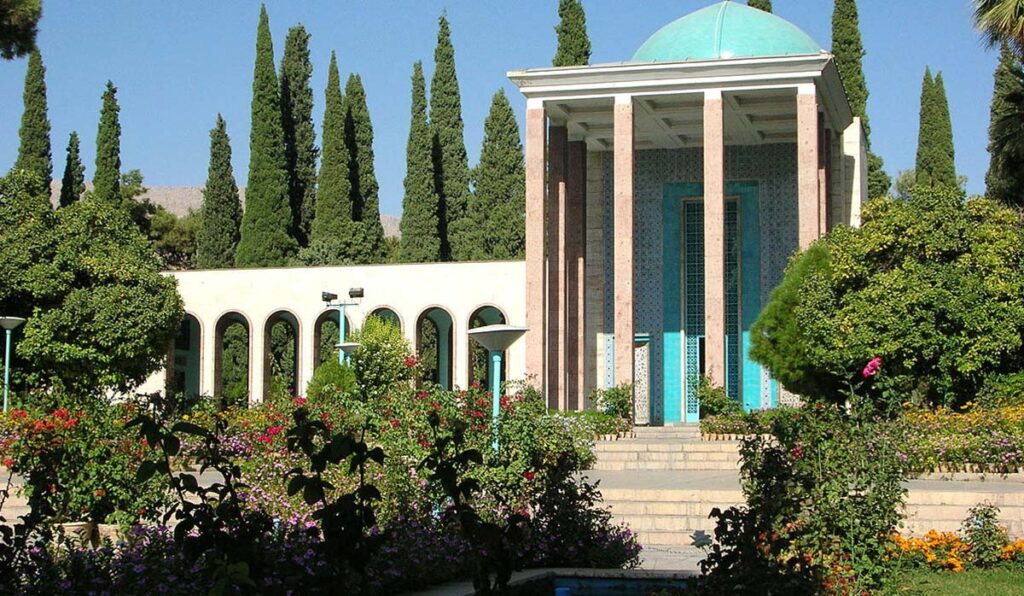
Another prominent attraction in Shiraz is Saadi’s Tomb, which houses the tomb of Saadi, the renowned Persian poet. Shams al-Din Muhammad bin Abdullah Shirazi, known as Saadi Shirazi, was a beloved poet and writer of the 13th century AH. Saadi’s Tomb was once a place of worship for Saadi and his followers and after his death, he was buried in a beautiful garden in this area.
The current structure of Saadi’s Tomb is a blend of traditional and modern architecture, constructed in 1951. The architecture features an authentic Iranian style with eight brown stone columns supporting a turquoise-tiled dome. The interior of the tomb is octagonal, with inscriptions of verses from Saadi’s works such as Golestan, Bustan, and his odes displayed in seven corners. Surrounding Saadi’s tomb are the graves of many other mystics and poets, including Shourideh Shirazi.
A notable feature of this complex is the Fish Pond located near Saadi’s tomb, filled with water from a clear spring beneath it. According to an old belief, the water in the tomb’s pools has healing properties. Today, many visitors throw coins into the pond, hoping to make a wish.
Visiting hours: 08:00 to 20:00
Address: Shiraz, end of Boustan Street, beside Delgosha Garden
Hafez’s Tomb
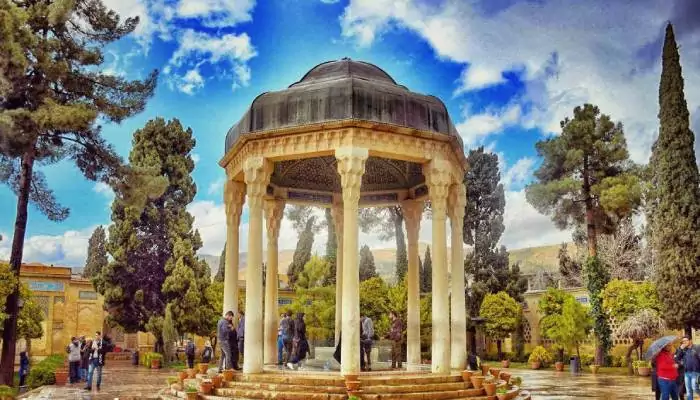
One of the most famous attractions in Shiraz is the Tomb of Hafez, the great Persian lyric poet Khwaja Shams al-Din Muhammad Shirazi. The unique design of this monument is one of the finest works of Andre Godard, a French architect. The main tomb structure is surrounded by eight beautifully carved columns, symbolizing the 8th century AH when Hafez lived. The interior of the dome is adorned with intricate mosaic tile work in Islamic geometric patterns, and the exterior is covered with copper plates, enhancing the beauty of the complex.
The Hafez complex features two courtyards, north and south, separated by a hall. The Hall of Hafeziyeh, constructed in the Zand era in the Iranian-Islamic style, has 20 stone columns, each 5 meters high, offering a magnificent view. The ambiance of Hafeziyeh at night is particularly enchanting; sitting in the serene atmosphere of the traditional teahouse and getting your fortune told beside Hafez’s tomb offers visitors a unique spiritual experience.
Visiting hours: 08:00 to 21:00
Address: Shiraz, between Adabiyat Crossroad and Hafeziyeh Crossroad, opposite Hafeziyeh Stadium
The Quran Gate | A Symbol of Shiraz
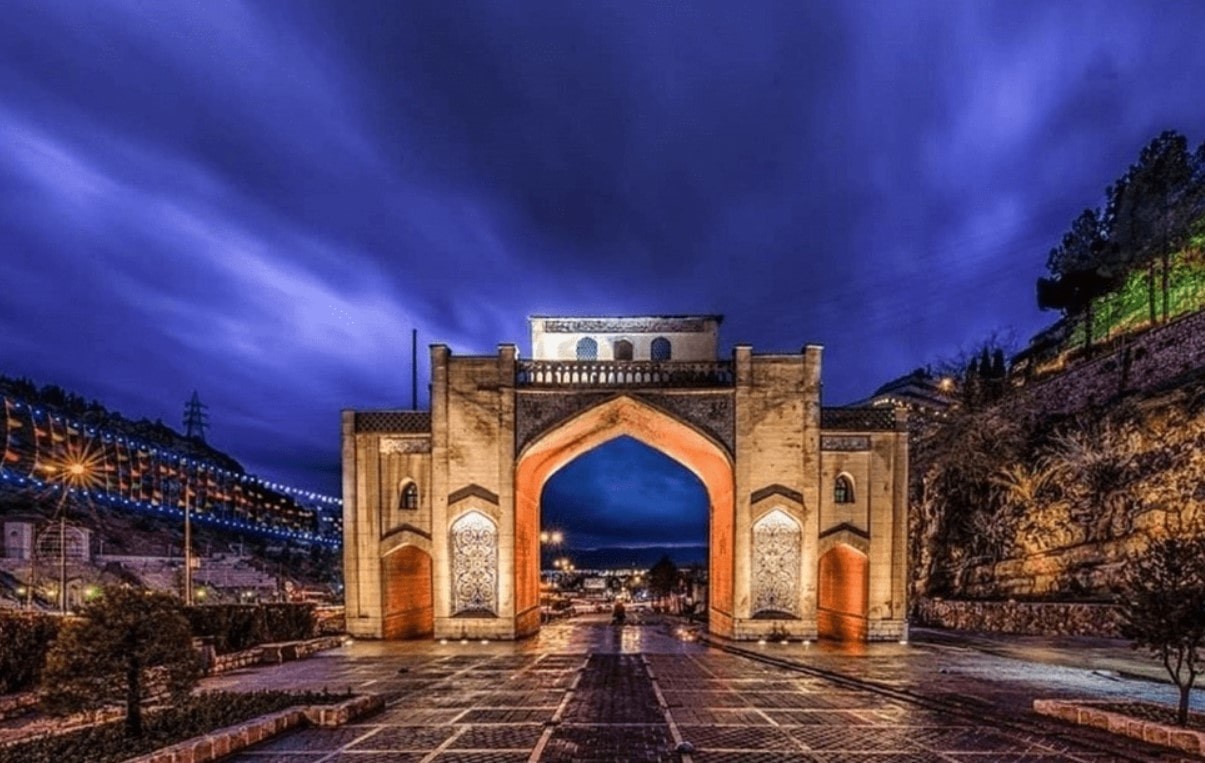
The Quran Gate is one of the remaining gates from old Shiraz, located in the Allah Akbar Gorge at the northeast entrance of the city. It was constructed by the order of Adud al-Dawla Deylami, and its name derives from the Quran that was placed above the gate for travelers to pass under for blessings and safe journeys. This precious Quran, made during the Zand period, is known as the “Seventeen-Man Quran” due to its heavy weight and is currently preserved in the Pars Museum. The gate is also adorned with Quranic verses written in Thuluth and Naskh scripts.
This gate, having been destroyed, rebuilt, and renovated multiple times, is one of the main symbols of Shiraz and is highly popular among locals and tourists. Nearby, you can find the tomb of Khwaju Kermani and Kouhpayeh Park, making it a pleasant spot for leisure. This structure was registered as a national heritage site in 1996.
Visiting hours: Open 24 hours
Address: Shiraz, Shiraz-Marvdasht Highway, entrance to Shiraz
Manteghi Nejad House | Amidst the Old Texture of Shiraz
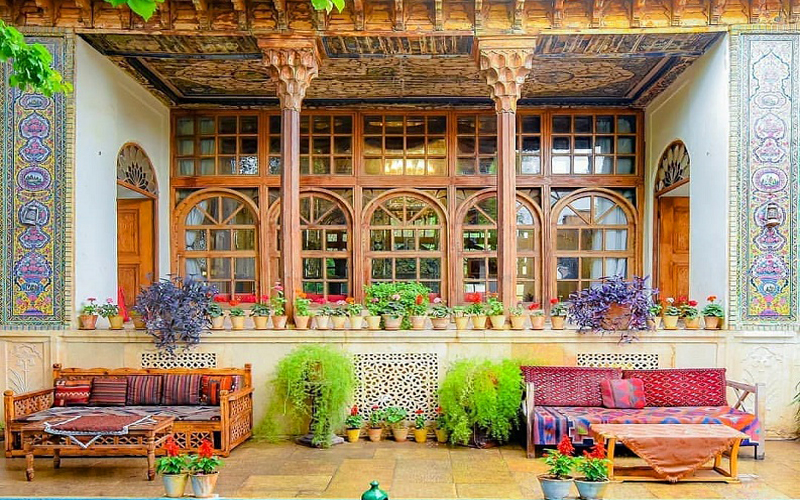
The historical Manteghi Nejad House, a splendid remnant from the Qajar era, is located in the old texture of Shiraz, near the holy shrine of Shah Cheragh. This house belonged to a Shirazi merchant named Manteghi Nejad and was constructed by skilled Shirazi artists and architects in 1932.
The house was added to the list of national heritage sites in 1973. After being restored and renovated, it opened in 2005 as the Museum of Islamic Arts and the Museum of Sounds, welcoming tourists and enthusiasts. Staying in one of Shiraz’s traditional hotels or accommodations gives you a chance to experience the ambiance of these historic houses.
Address: Shiraz, Dasht-e Cheib Boulevard, 9th Dey Boulevard, behind the Mosque
Forough al-Molk House | Meshkinfam Art Museum
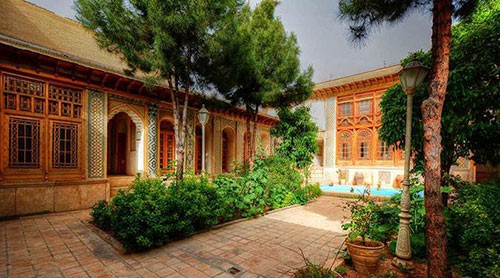
One of the notable attractions in Shiraz is the Forough al-Molk House, located in the old neighborhood of Sang-e Siah. This historical house dates back to the late Qajar and early Pahlavi periods. It was built for residential purposes and includes two separate courtyards, an inner and outer section, a kitchen, a Shah-Neshin mansion, a pool house, a bath, a stable, and more.
The Forough al-Molk House was converted into a museum in 2002 by Mr. Hassan Meshkinfam, following its restoration. Today, it is known as the Meshkinfam Art Museum and hosts various contemporary artworks, including paintings, calligraphy, and valuable sculptures.
Visiting hours: 09:00 to 12:00 – 16:00 to 18:00
Address: Shiraz, Sang-e Siah neighborhood, behind the Imamzadeh Bibi Dokhtaran
Haft Tanan Stone Museum
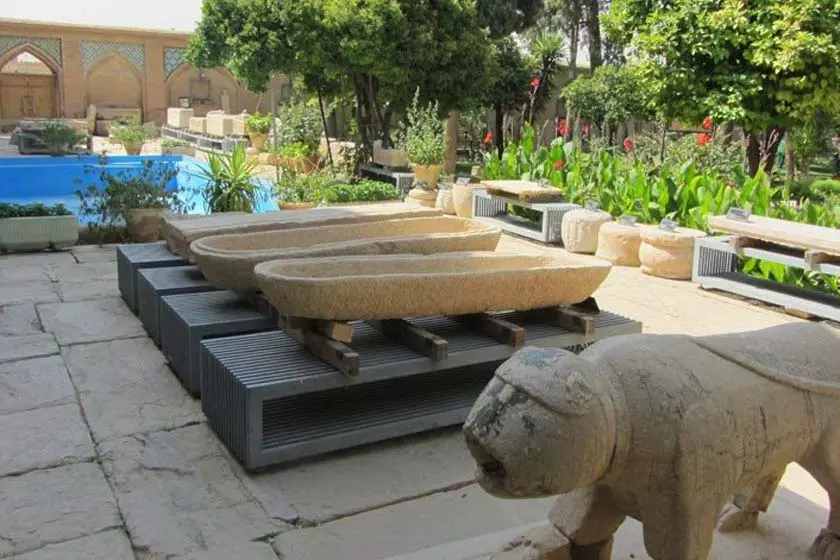
The Haft Tanan Tekyeh, also known as the Stone Museum, is a relic from the Zand period located at the foot of Chehel Maqam Mountain in northern Shiraz. The name “Haft Tanan” refers to the seven unknown mystics buried there. Karim Khan Zand, who held these mystics in high regard, ordered the installation of seven large, inscription-less stones over their graves.
Upon entering this garden, a large pool and various 200-year-old trees like cypress, pine, and orange trees greet you. The structure is divided into northern and southern parts. One of the most beautiful features of this mansion is the two large stone columns in the northern section and the second floor, decorated with meaningful and exquisite paintings. This monument has been listed as a national heritage site since 1931.
Visiting hours: 07:30 to 19:30
Address: Shiraz, at the foot of Chehel Maqam Mountain, north of Hafez’s Tomb
Introducing the Gardens of Shiraz
Shiraz is famous for its beautiful spring season, marked by lush greenery and the fragrance of its renowned orange blossoms. If you visit Shiraz, especially in May, make sure to explore its famous gardens to witness the city’s unparalleled beauty. Here are some of the most beautiful gardens in Shiraz:
Eram Garden of Shiraz

When you travel to Shiraz, don’t miss visiting Eram Garden. This historical garden, spanning 1,100 square meters, is full of diverse and beautiful flowers, making it a perfect botanical garden. Tall, majestic trees alongside Persian architecture enhance its beauty.
The construction of Eram Garden dates back to the 16th and 17th centuries, but it was renovated during the Zand dynasty. Nasir al-Din Shah built the Ilkhani Mansion in this garden, which now serves as the burial site for some Qashqai tribe leaders. After visiting Eram Garden, you can explore nearby attractions like the Tomb of Hafez, the Tomb of Saadi, Karim Khan Citadel, and Vakil Bazaar.
Visiting hours: Every day from 8:00 AM to 8:30 PM
Address: Shiraz, Eram Street
Delgosha Garden
The scent of orange blossoms is more prominent here than anywhere else. Delgosha Garden is one of the oldest and most beautiful gardens in Shiraz, dating back to the Sassanian era. During the Safavid period, it was used as a recreational spot, but it was largely destroyed during the Zand dynasty. Karim Khan Zand restored it, making it popular and attractive again. In the Qajar era, Haj Ebrahim Etemad-od-Dowleh Shirazi renovated Delgosha Garden.
Interestingly, the restoration took about three decades, but for 50 years, it was owned by the daughter of Qavam al-Molk and her husband, Nazem al-Molk. The garden features the best Kolah Farangi mansion, which is more attractive than other similar structures. The garden also houses a museum with artifacts from the Achaemenid to the Qajar periods. The Quran Gate, Nasir al-Mulk Mosque, and the tombs of Saadi and Hafez are nearby, making them perfect to visit after exploring Delgosha Garden.
Visiting hours: First half of the year: 8:00 AM to 11:00 PM; Second half of the year: 8:00 AM to 10:00 PM
Address: Shiraz, between Delgosha Street and Narenjestan
Afif-Abad Garden

The 127,000 square meter Afif-Abad Garden is one of the beautiful and unique gardens in Shiraz that you must visit. The garden dates back to the Safavid era. Within this garden lies a stone fortress called Golshan Fortress, which was of special importance during the Safavid period.
During the Qajar era, Mohammad Ali Khan Qavam al-Molk purchased and renovated the garden, breathing new life into it. The heavily damaged Golshan Fortress was demolished, and the current Afif-Abad Mansion was built in its place. The garden is named after its last patron, Afifeh Khanum, the niece of Qavam al-Molk, who revitalized the garden, giving it the name Afif-Abad. Since 1972, this garden has been listed as a national heritage site.
The main sections of Afif-Abad Garden include the Iranian garden, traditional bathhouse, coffeehouse, Ebrat Museum, Military Museum, and the Royal Palace, all of which are must-see attractions.
Visiting hours: First half of the year: 8:00 AM to 7:00 PM; Second half of the year: 8:00 AM to 5:00 PM
Address: Shiraz, end of Afif-Abad Street
Jahan Nama Garden

Another historical garden in Shiraz is the Jahan Nama Garden, dating back to the 14th century. During the Zand dynasty, especially under the rule of Karim Khan Zand, it was one of the most popular gardens in Shiraz. As soon as you enter Shiraz, the first garden that catches your eye is the Jahan Nama Garden.
Located on Hafez Street, near the Quran Gate, this garden was also known as the Vakil Garden during Karim Khan Zand’s reign. However, during the reign of Fath-Ali Shah, it was renamed Jahan Nama. It is said that Timur the Lame was so enchanted by this garden that he ordered a similar one to be built in Samarkand.
Visiting hours: 8:30 AM to 9:00 PM
Address: Shiraz, Eastern side of Hafez Street, above Hafezieh Square
Religious Buildings
Shiraz is one of the few cities that, alongside its historical and recreational attractions, also boasts many religious sites that draw thousands of Muslims and Shia pilgrims from across Iran every year. Below are some of the most famous and important religious attractions in Shiraz:
Shah Cheragh Shrine
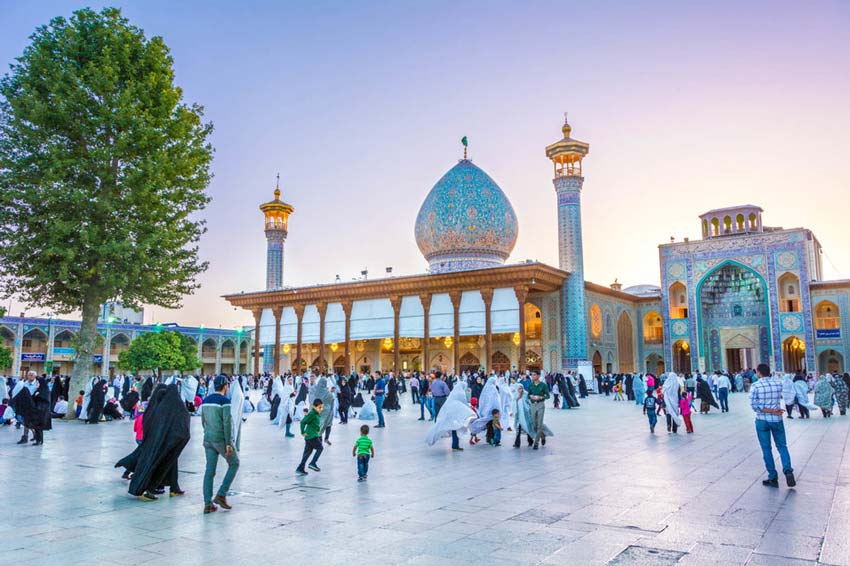
The most important religious attraction in Shiraz is the Holy Shrine of Ahmad ibn Musa, known as Shah Cheragh. Ahmad ibn Musa was the brother of Imam Reza (AS) and the son of Imam Musa al-Kadhim (AS). On his journey to Khorasan to join his brother, he was martyred in Shiraz by the Abbasid Caliph Ma’mun. The Shah Cheragh Shrine, in addition to its stunning architecture, captivates every visitor and pilgrim with its beautiful mirror work and tile work.
The courtyard of the shrine has two main entrances on the north and south sides, and four royal chambers can be seen around the shrine. The tomb of Ahmad ibn Musa is located under the dome in the western part of the courtyard, and to the east lies the tomb of his brother, Sayyid Mir Muhammad (AS). The shrine also has four courtyards named the Main Courtyard, the Ancient Courtyard, Imam Jawad (AS) Courtyard, and Lady Masooma (AS) Courtyard.
Visiting hours: 24 hours
Address: Shiraz, 9 Dey Street
Atiq Jameh Mosque
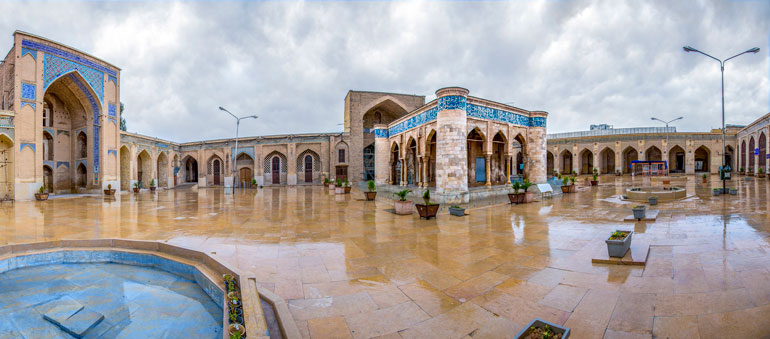
One of Iran’s oldest mosques, Atiq Jameh Mosque, also known as the Friday Mosque, stands as the oldest mosque in Shiraz, situated in the heart of the city’s historic district, east of the sacred shrine of Shah Cheragh. Mentioned as an unparalleled mosque in Ibn Battuta’s travelogue, it is regarded as Shiraz’s first religious nucleus. According to ancient inscriptions, the history of this structure dates back to the late 8th century AH (200 AH).
The main entrance to the mosque is the northern entrance, beautifully adorned with tiles, and the names of the twelve Imams are inscribed on the archway, dating back to the Safavid era. As soon as you step into the mosque’s courtyard, what initially captures attention is the four-sided structure of the Khodaykhaneh, with round pillars adorned with ancient inscriptions in its corners, presenting a beautiful sight. This structure used to serve as a repository for the Quran and religious books, a place for teaching religious matters, and for Quran recitation.
Visiting hours: 8:00 AM to 8:00 PM
Address: Shiraz, Southeast side of Shah Cheragh
Imamzadeh Ali ibn Hamzeh
Imamzadeh Ali ibn Hamzeh is one of Shiraz’s historical and religious landmarks, belonging to Shah Mir Ali ibn Hamzeh ibn Musa al-Kadhim, the grandson of Imam Musa al-Kadhim (AS). His shrine is adorned with exquisite calligraphy and beautiful tilework, captivating the eyes of every visitor. The entrance to this shrine is intricately carved and unique, adding to the beauty of this sacred place.
Located in the northeast of Shiraz, near the Quran Gate, this holy site is easily accessible.
Visiting hours: 8:00 AM to 6:00 PM
Address: Shiraz, Hafez Street, Corner of Shahid Emadi Street
Baba Koohi Mausoleum
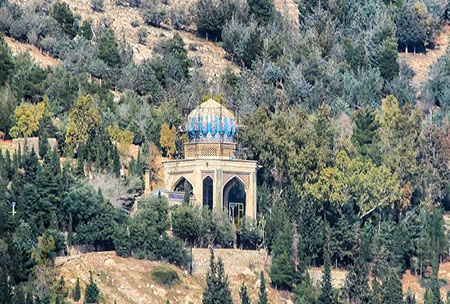
One of Shiraz’s attractions is the Baba Koohi Mausoleum, dating back to the Albooyeh dynasty. Situated in the foothills of the northern mountains of Shiraz, visitors can reach this religious site with a 30-minute hike. The path to this mausoleum, nestled in the heart of the mountains, has become one of the favorite hiking trails for the people of Shiraz, offering a breathtaking view of the city.
Within the mountain, there are two caves, one of which houses the mausoleum of Sheikh Abu Abdullah Muhammad ibn Abdullah, known as Baba Koohi, and the other was the residence of one of the mystics of that era.
Visiting hours: Open 24 hours
Address: Northern mountain range of Shiraz, left side of the Quran Gate, Kooh Baba Koohi
Tourist and Recreational Attractions in Shiraz
1. Khaleej-e Fars Complex Shiraz
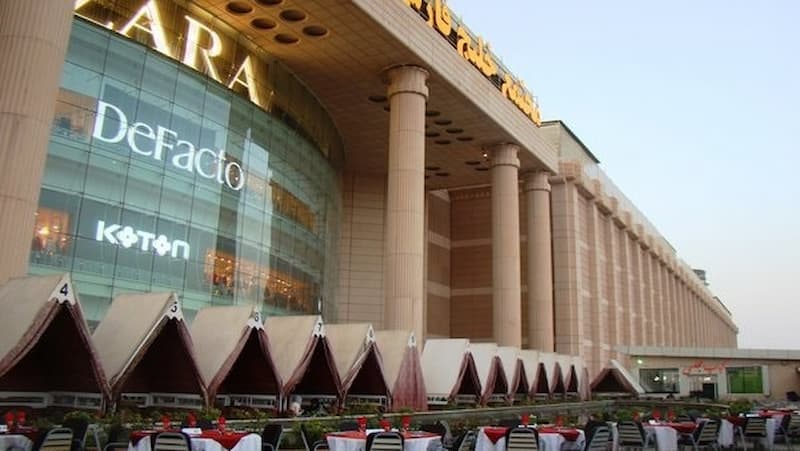
Description: Khaleej-e Fars is a commercial complex with over 2500 commercial units, offering various recreational services including a large amusement park, luxury cinemas, multiple restaurants and cafes, hypermarkets, and more.
Visiting Hours: 9:00 AM to 11:00 PM
Address: Dr. Hossebi Highway, Beginning of Sadr New City Entrance, Shiraz
2. Ghavareh Dideh Z (Ghavareh Dideh Tower)

Description: Also known as Ganbd-e Azd or Ghavareh-e Div, this lesser-known attraction offers stunning panoramic views of Shiraz. It was built during the Buyid period and serves as an observation tower.
Visiting Hours: Open 24 hours
Address: Northern Entrance of Shiraz, Opposite Qur’an Gate
3. Drak Mountain Park
Description: Located in the foothills of Drak Mountain, this park offers breathtaking views of Shiraz, especially at night. It hosts Iran’s longest zip line, measuring 1200 meters in length and 200 meters in height.
Visiting Hours: 8:00 AM to 11:00 PM
Address: Hossein Alhashemi Boulevard, Shiraz
4. Azadi Park
Description: One of Shiraz’s oldest parks, Azadi Park, also known as City Park, is the largest park in Shiraz. It features a thrilling amusement park with rides such as Ferris wheels, aerial trams, and Viking ships. There’s also an artificial lake in the middle where visitors can go boating.
Visiting Hours: Open 24 hours
Address: Azadi Boulevard, Gas Square, Shiraz
5. Pouladkaf Ski Resort, Sepidan
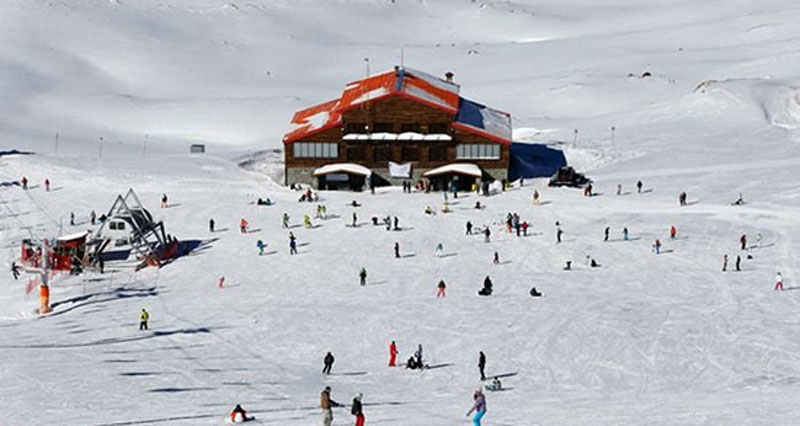
Description: Pouladkaf Ski Resort in Sepidan is Southern Iran’s first ski resort, covering 500 hectares. It’s the second-largest international ski resort in Iran. In summer, it transforms into a bustling ski market on grass. Facilities include a 4500-meter hotel, ski lift, ski school, restaurant, mountain car, and more.
Visiting Hours: Open 24 hours
Address: Fars Province, Sepidan, 85 kilometers northwest of Shiraz
Don’t miss out on the must-see places in Shiraz! There are plenty of attractions and sights in Shiraz, and in this article, we’ve tried to introduce the most prominent ones to you. This city boasts many beautiful and captivating gardens, which you can fully explore in the article on the most beautiful gardens of Shiraz.
If you’ve also had the experience of traveling to Shiraz, share your thoughts about this city with us. Which attraction in Shiraz do you think is worth seeing the most?
Frequently Asked Questions About Shiraz Attractions:
What are the notable gardens in Shiraz?
Eram Garden, Afifabad Garden, Narenjestan Garden, Delgosha Garden, Jahan Nama Garden.
What are the must-visit places in Shiraz during winter?
The Poladkaf Ski Resort on the road to Margoon Waterfall is an excellent place for winter sports during the winter season.
What is the best time to travel to Shiraz?
Spring, especially during the months of April and May, is the best time to visit Shiraz.

